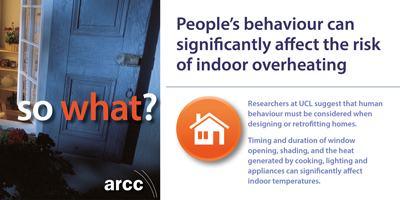Researchers at UCL have found that the way occupants operate their homes can significantly affect the risk of indoor overheating. The use of shading and night-time cooling are particularly effective in reducing summer indoor temperatures.
People’s behaviour inside their homes has an important impact on how much the building overheats during periods of hot weather.
The risk of indoor overheating in UK homes is likely to increase in future due to improved energy efficiency standards and the changing climate. This study modelled the impact of a range of lifestyle and behaviour scenarios on indoor temperature. Results show that the timing and duration of window opening and use of shading, and the heat generated by occupants themselves through cooking, lighting and appliances, can affect internal temperatures significantly.
Relevance
As summers become warmer, UK homes face an increased risk of indoor overheating. To meet carbon emission reduction targets, homes are increasingly insulated and airtight, which could also potentially make them warmer during the summer.
The risk is higher in cities due to the urban heat island effect –urban temperatures are often higher than those of surrounding rural areas, especially at night. For people living in cities, relying on opening windows to cool down their homes may be difficult due to high outdoor air pollution, noise and security issues.
Currently, we know very little about people’s behaviour inside their homes, particularly during the summer months. Current public health guidelines, such as the Heatwave Plan for England, recommend actions, such as window opening and shading, to reduce high summer temperatures. However, such actions may be challenging for the elderly and individuals with low mobility.
Findings
- Heat discomfort and health risk are significantly higher for occupants who never open their windows, such as older or bedridden individuals and people with pets, but also for people living in polluted, noisy or unsafe areas.
- Certain energy-saving retrofits were found to generally increase indoor temperatures.
- Shading windows that receive direct sunlight during the day and ventilating the home when external temperatures are lower can significantly reduce the risk of overheating.
- Night cooling and daytime shading is more effective than simply opening windows during the day.
Now what?
The design and retrofit of UK homes should be robust and take into account a range of occupant behaviours and climate change scenarios.
We currently design our homes for a ‘standard’ occupant and with a fixed climate in mind. A different approach in the way we construct and refurbish dwellings is needed to ensure that our housing stock is well prepared for a warmer climate. Housing designers and providers should provide training for residents to educate them about building controls and optimum adaptive actions during a heatwave. Particular focus should be given to high risk properties, such as urban apartments, and vulnerable individuals.
Residents
- Familiarise yourself with guidance on how to stay cool during hot weather.
- Switch off lights and appliances when not in use.
- Use shading, if available.
- Be prepared to reconsider current practices: for example, keeping windows closed when it is hotter outside may not seem logical, but opening them will not cool down your home.
Homeowners / landlords
- Prioritise passive cooling strategies – shading, cross ventilation etc. – over active ones, e.g. air-conditioning.
- If retrofitting your property, ensure that a cooling strategy has been integrated in the plan.
Policymakers / housing associations
- Educate the public on overheating prevention.
- Avoid placing vulnerable individuals in properties at high risk of overheating.
- Provide advice and support for people occupying dwellings that are difficult to cool with conventional means.
Architects / retrofit providers
- When designing a new home or retrofitting an existing building, optimise its thermal performance not only for the winter, but also for the summer period.
- Where possible, use dynamic thermal simulation to test the thermal behaviour of the building for different occupant profiles.


